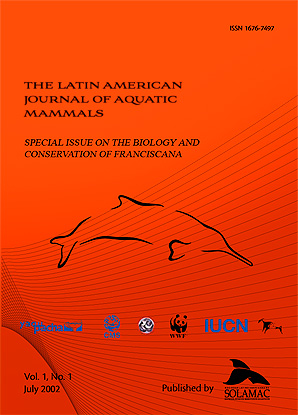Size and shape variability in the skull of <i>Pontoporia blainvillei</i> (Cetacea: Pontoporiidae) from the Brazilian coast
DOI:
https://doi.org/10.5597/lajam00018Abstract
The existence of sexual dimorphism in Pontoporia blainvillei has long been known, with females being larger than males. However, no study so far has explored this dimorphism separately in its size and shape components. Here we analyse sexual dimorphism present in eight linear measurements of the skulls of 56 specimens (30 females and 26 males) of P. blainvillei from several localities along the Brazilian coast. We also investigate the sexual dimorphism in size and shape using geometric morphometric techniques, employing a subsample of the specimens above consisting of 27 skulls (12 females and 15 males). The analysis was based on landmarks digitized in four views of the skull: dorsal, ventral, lateral and occipital. A PCA showed the existence of two distinct populations, thus requiring the separation of two samples for the analysis of the effects of sexual dimorphism. Results of traditional and geometric morphometrics analyses revealed no sexual dimorphism in shape. All differences observed between the sexes are size related, with females bigger than males. Shape, however, is an important factor in the differentiation of at least two populations of this species.Downloads
How to Cite
Higa, A., Hingst-Zaher, E., & Vivo, M. (2002). Size and shape variability in the skull of <i>Pontoporia blainvillei</i> (Cetacea: Pontoporiidae) from the Brazilian coast. Latin American Journal of Aquatic Mammals, 1(1), 145-152. https://doi.org/10.5597/lajam00018
Issue
Section
Articles
License
Authors who publish with this journal agree to the following terms:- Authors retain copyright and grant the journal right of first publication with the work simultaneously licensed under a Creative Commons Attribution License that allows others to share the work with an acknowledgement of the work's authorship and initial publication in this journal.
- Authors are able to enter into separate, additional contractual arrangements for the non-exclusive distribution of the journal's published version of the work (e.g., post it to an institutional repository or publish it in a book), with an acknowledgement of its initial publication in this journal.
- Authors are permitted and encouraged to post their work online (e.g., in institutional repositories or on their website) prior to and during the submission process, as it can lead to productive exchanges, as well as earlier and greater citation of published work (See The Effect of Open Access).


